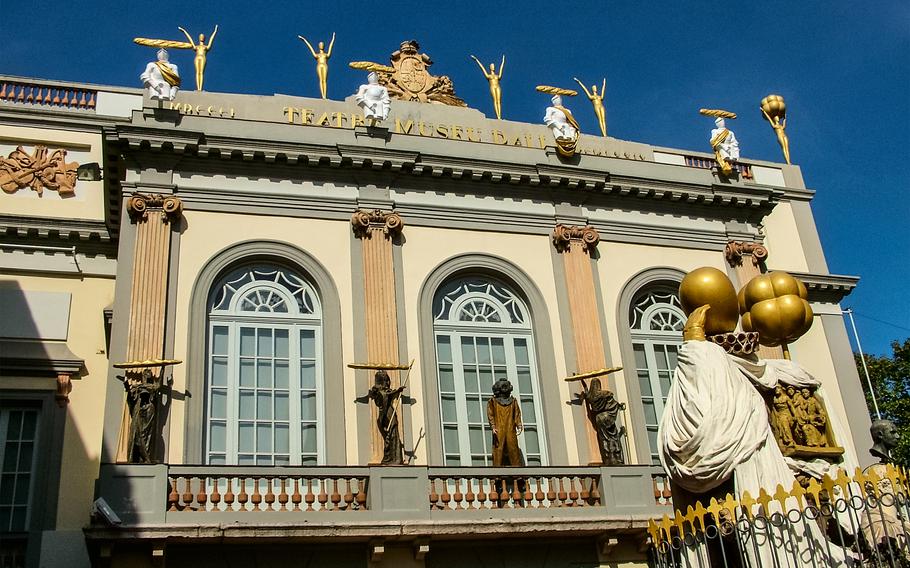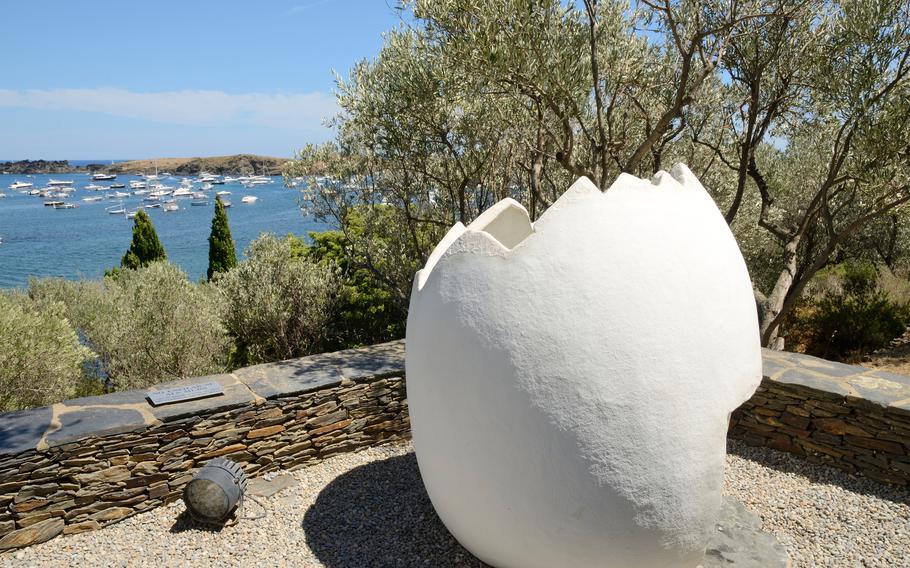
The Dali Theater-Museum in Figueres, Spain, was designed and built by Salvador Dali and celebrates his life and work as one of the most intriguing artists of the 20th century. (iStock)
What’s yesterday in Girona, in Catalonia, Spain, but as tomorrow as a trip to Mars? Surely not the 6th century BCE ruins at Empuries, nor the coastal Roman road, the Via Augusta, now paved and numbered. Nor is it Girona’s vineyards or the Costa Brava’s sandy shores and emerald coves.
The word is that the Dali Theater-Museum, celebrating the life and work of its enigmatic founder Salvador Dali (1904-1989), Girona’s world-famous surrealist artist, is rated among the city’s most-visited tourist attractions. Both revered and reviled during his lifetime, Dali is now recognized as a visionary.
His most recognized painting, the “Persistence of Memory,” in the Museum of Modern Art in New York, depicts – according to some – a dying world, melting watches marking its last hours. Or as the guide in the Dali Theater-Museum explained to the tour group I joined, the painting clearly suggests that dream time is elastic, the drooping clocks a clue to their creator’s inner life.
“Is this painting symbolic, or is it a joke?” asked a frowning young man who’d been standing silently, pondering an image of Dali’s wife titled “Galatea of the Spheres.” The guide blinked, the group moved on and the query went unanswered. Fortunately for art historians, Dali, a native of Girona, left as many clues as he did paintings.
Dali’s house in Port Lligat and his wife’s house in Pubol, both open for guided tours, offer surprising insights into the artist and the man. Sunny days in the beach town of Cadaques, 15 minutes from Port Lligat, where his family summered – and where I spent a charmed afternoon – fostered a love of the sea. And for a close-up of Dali’s last decade and most ambitious projects, spend an afternoon in the inimitable Dali Theater-Museum, in Figueres, where he grew up, a building he designed and built on the site of his favorite movie theater.
I should have started there when I headed to Girona for a long-planned, two-week escape. But Salvador Dali was the last thing on my mind. I’d been to the Costa Brava years earlier, stayed a couple of days and spent most of it on what I’d remembered as the world’s most enchanting beach. Going back again, I realized it was a town with a history. Settled 2,000 years ago by the Iberians and officially founded by the Romans in the 5th century, Girona is a proud survivor.
Free to wander, I spent a couple of days exploring the restored Old Quarter, following the path of the semi-restored 4th century Roman wall and visiting various 10th and 11th century monasteries and towers. Exploring the center’s narrow cobblestone passageways I found a sunny spot, with a café under a couple of shady trees, my lodestone for the rest of the trip.
On the advice of Marco, the hotel clerk, who said he was more interested in movies than history, I explore the 12th century Romanesque Cathedral, climbing the 91 stone steps up to the entrance. “Those are the steps that the ‘Game of Thrones’ used, filming the last season,” he said, beaming. Unusually large for a Romanesque building, the cathedral boasts Europe’s widest single-nave interior. Counting the steps, I thought of the countless numbers of people who’d walked there before and felt lucky to be a visitor.
Curious about seeing the coast north of Girona, I booked a bus tour heading north to the Cap de Creus, the rocky peninsula jutting into the Mediterranean Sea. The trip, winding through rugged, bush-covered hills, ends at a windswept cliff, part of a chain of small bays heading north and south. Gazing out to sea, we — the bus riders — spotted a sailboat leaning into the wind, heading north toward the French border, 16 miles away. Long before there was a border, Phoenician and Greek ships sailed this way, trading with coastal villages like Empuries.
Ten days into my vacation, done with museums and the occasional vineyard tour and wine-tasting, I headed to the beach, still the cleanest sand and most translucent water on the Mediterranean’s western shores. Striking up a conversation with a couple of Canadians sunning nearby made the afternoon fly by. They had rented an apartment for six weeks, I had a hotel room. They were going on to Madrid, I was flying back to Denver. We both skied in British Columbia, at Whistler Blackcomb. And they wanted find out more about Salvador Dali.
So I tagged along, heading first to Pubol Castle, the 12th century mansion Dali bought in 1970 for his wife Gala. Larger than it appears from the entrance, the mansion, completely restored, consists of a main house with a tower and covered passageways, surrounded by gardens.
Waved in with another group, we listened as the guide ran through a brief history: the renovation of the building, Dali’s artwork and the decade that Gala lived there alone, entertaining overnight guests, including men, but keeping Dali out, except by her written invitation.
“People always wonder why she wanted a house of her own,” she said, when we were alone and I asked. “Dali was 67 or 68 then, and Gala was 77, 10 years older than he was. Too old to want another man, you’d think. He loved her, but they couldn’t live together. Like many couples.”
Whatever the reason, Dali rebuilt the place and surrounded it with gardens. He tucked homemade stick-thin elephants into the branches and furnished the bedrooms with satin and velvet, fit for a queen. Installing modern bathrooms and a kitchen, he made it livable. And he filled it with paintings, ceiling murals, wall hangings, hand-decorated tiles, tables, chairs, mirrors and dozens of baubles and charms. A packrat myself, it tickled my fancy seeing that he, too, couldn’t resist objets d’art.
Spotting a lion’s head atop an 19th century wardrobe (a closet for hanging clothes), next to a framed fuzzy photo of a head, I took a second look. Comic theater, perhaps? Or was Dali spoofing the book “The Lion, the Witch and the Wardrobe?” He could have read it when they fled Spain for New York City in 1940, after the Nazis invaded France.
Tucked away by itself was a photography exhibit devoted to pictures of Dali and Gala in their Manhattan studio, in black and white. She’s laughing for the photographer, and he, ever the showman, is clowning, posing with his trademark mad-man stare and long, curved mustache.
The next day we headed for Dali’s adult home on the shore in Port Lligat, a house filled with lamps, candlesticks, tools, bowls, canvases, art supplies, cushions, souvenirs, beads, an outdoor patio and fountain, a stuffed bear next to the stairs and chains of dried, white “everlasting” flowers. The sort of things a teenager might collect.
According to Maria, our guide, the big white eggs on the roof were a link to his older brother, who shared his name but died at nine months of age, just before Dali was born. The single cracked egg, she said, big enough for a man to climb inside, represented his brother, his other half, without whom – according to hearsay – he never felt complete.

Salvador Dali’s adult home on the shore of Port Lligat, Spain, includes big white egg sculptures on the roof. Guides say they were a link to Dali’s older brother, who died in infancy just before Dali was born. (iStock)
I’d already been to the museum in Figueres; now I wished I’d saved it for last. After making another reservation, I went again, walking and looking. This time the place was packed, the rooms crowded with guided tours. Don’t come on Saturday if you can avoid it. But if drooping clocks make you wonder, this is the place where the symbols click and the pilgrimage ends. I think. At the very least, I left with new respect for one of Spain’s greatest 20th century painters.